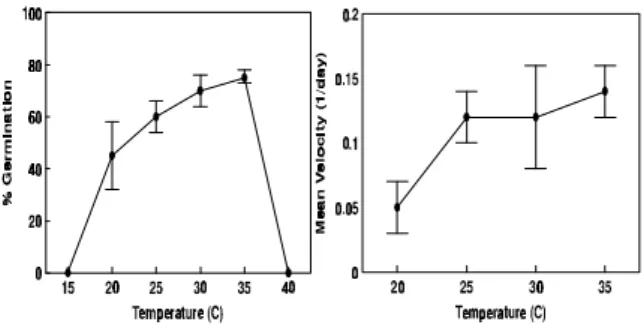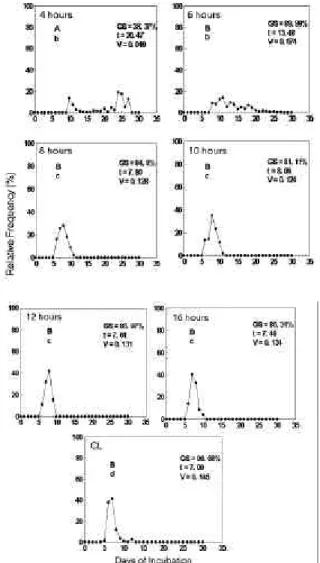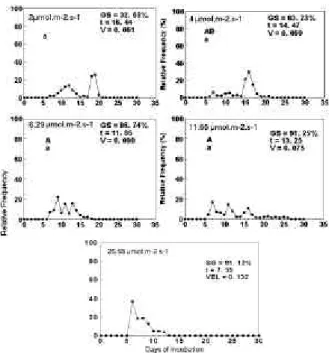Vol. 44, N. 3 : pp. 297 – 302, September, 2001
ISSN 1516-8913 Printed in Brazil
BRAZILIAN ARCHIVES OF
BIOLOGY AND TECHNOLOGY
A N I N T E R N A T I O N A L J O U R N A L
Phytochrome and Temperature Control of Seed
Germination in
Muntingia calabura
L. (Elaeocarpaceae)
Idalina T. de A. Leite
1and
Massanori Takaki
2*1
Universidade de Alfenas, Alfenas - MG, Brazil; 2Departamento de Botânica, UNESP, CP 199, Rio Claro - SP, Brasil
ABSTRACT
The temperature range of germination of seeds of Muntingia calabura L. was 15-35°C and the optimum temperature at 35°C where more seeds germinated at short period. The fluence response curves demonstrated the involvement of phytochrome in the control of germination through the low fluence response. The effect of photoperiod showed that the species need long daily exposures to white light and that shade light inhibited completely seed germination, confirming as pioneer species that colonized only large gaps in the forest.
Key words: Seed germination, phytochrome, light, temperature, Muntingia calabura
*
Author for correspondence
INTRODUCTION
The ecophysiological study of seeds allows the understanding of the mechanisms which regulate seed longevity in the soil, dormancy breaking, germination and plant establishment in natural conditions. This is a crucial aspect of plant biology is crucial when studying species which only became established in disturbed sites of mature vegetation (Vazquez-Yanes & Orozco-Segovia, 1982).
Light is one of the most important environmental factor regulating growth and development of plants. When absorbed by chlorophyll, light represents a source of energy. However, when absorbed by phytochrome, light controls plant photomorphogenesis. Phytochrome exists under a red (Pr) and a far-red (Pfr) absorbing distinct forms. Upon exposures to red light, Pr undergoes photochemical conversion to a physiologically active far-red absorbing form, Pfr, which triggers a variety of complex physiological responses such
as flowering and seed germination (Mancinelli, 1994).
Therefore, as pointed out by Casal and Sánchez (1998) phytochrome enable the plant to detect shading by other plants and thus induces the alteration of metabolism and development. Phytochrome is, then, extremely important for plants growing under canopies, under natural conditions. In such situations, plants experience not only a reduction in irradiance but also altered spectral light quality due to selective absorption of blue and red wavelengths by chlorophyll. In particular, the red to far-red ratio (R/FR) of incident light may be dramatically reduced under a closed canopy compared with values in sunlight, and may also vary widely. Thus, R/FR is an important cue by which plants may detect microenvironmental variation in vegetation shade, both from overstory foliage and from neighbors (Schmitt et al., 1999).
induced photosensitivity of seeds is often interpreted as an adaptation ensuring that seeds will germinate in sites in which the probability of seedling establishment is high. Such a mechanism would be particularly advantageous for species with small seeds whose seedlings cannot survive in established vegetation (Gross, 1985).
Temperature is another factor which controls seed germination in the nature, and the knowledge of cardinal temperatures is important for the understanding of plant species occurrences (Labouriau & Agudo, 1987). The light requirement by seeds is also dependent on the temperature as reported by Smith (1982).
Muntingia calabura is a pioneer species which occurs from Southern Mexico to Bolivia and Brazil and it has been used in heterogeneous reforestation of disturbed areas (Campos, 1982). In the present work we analyzed the effect of light and temperature on seed germination of M. calabura.
MATERIAL AND METHODS
Fruits of M. calabura were collected from five individuals in Piracicaba and Rio Claro, São Paulo State, Brazil. Seeds were extracted from fruits by peeling them and passing through a plastic strainer and then washed in distilled water. After this
procedure, these were dried at 25°C for at least 24
hours and stored in closed jar at 5°C.
Seeds were sowed in 5mm diameter Petri dishes with filter paper imbibed with distilled water. All experiments were carried out in four replicates. The number of seeds in each Petri dish was random, due to reduced seed size as proposed by Cone and Kendrick (1985) for Arabidopsis thaliana. Seeds were scored daily and those with at least 1mm long root were considered as germinated. At the end of the tests, the remaining not germinated seeds were counted to attain the total number of seeds in each Petri dish. Seeds incubated under darkness were scored under dim green safe light (Kendrick & Frankland, 1969). White light was obtained with the aid of 15W day-light fluorescent lamps. Far-red day-light was obtained with the aid of two of each red and blue cellophane papers wrapping the 25W incandescent bulbs. The light fluences and 655-665 and 725-735 nm fluences were measured with the aid of a
LI-Temperatures from 15°C to 40°C were tested at
5°C intervals under continuous white light and
darkness for determination of optimum temperature. Photoperiods from 0 to 24 hours were
tested at 35°C under white light (25.55µW.m-2).
For fluence-response curves, seeds were sowed in Petri dishes placed in plastic trays under different fluences achieved using colorless or neutral glass plates and neutral plastic mesh. Shade light effects
on seed germination were tested at 35°C and the
seeds were kept under white light enriched with
far-red. Simulated canopy had 6.85µW.m-2, and
calculated photoequilibrium of phytochrome of 0.2 (Mancinelli, 1993).
Percentage, velocity and relative frequency of germination, were determined according to Labouriau and Agudo (1987) as follow:
G=(n/a)x100; V=1/t; t=(Σni x ti/Σni); FR=ni/Nt,
where n= total number of germinated seeds; a= total number of seeds; ni= number of germinated seeds between two consecutive observations (t-1) and (ti) and Nt= number of germinated seeds. The
significance of arcsin√%/100 among treatments
were obtained by Tukey test (Snedecor & Cochran, 1967).
RESULTS
Temperature strongly affected germination of M.
calabura seeds, as shown by Figure 1 and 35°C
was the best temperature for germination percentage and velocity. Accordingly, as temperature increased, germination velocity increased significantly. Figure 2 shows the polygons of relative frequency of seed germination, demonstrating that germination was more homogeneous with a well defined peak of germination at 30° and 35°C.
Long photoperiod also induced germination of these seeds. (Figure 3). The best germination percentage was obtained for seeds exposed to 6 hours of light or more, while germination velocity demonstrated that at least 8 hours were necessary. After such value, light exposure does not improve nor impair mean time to germination. Mean velocity of germination also profits from light exposure, in similar way as for mean time. The figure 4 shows that germination was more uniform as of 8 hours photoperiod, with a well defined germination peak. Statistically differences are shown in the figure 4.
Figure 2 - Polygons of Relative Frequency to
temperature effects on seed germination of M. calabura in light conditions. GS = % of germinated seeds; t = mean time for germination; V = mean velocity of germination. The letters show statistics differences between treatments. The capital letters refers to germination percentage and the tiny ones refer to velocity.
Figure 3 - Effects of photoperiod on germination of M. calabura seeds. (A) percentage of germination; (B) mean time velocity to germination.
The curve of fluence-response demonstrated the dependence of porcentage and velocity of germination with the white light fluence (Figure 5). Figure 6 shows the polygons of relative frequency of germination, which showed that with
25.55 W.m-2, germination had a well defined peak,
after 7.5 days from sowing. At the other fluences, the germination of seeds was more scattered in time. No germination was observed under shade light, showing that seeds of M. calabura do not germinated under canopy in natural conditions.
Figure 4 - Polygons of Relative Frequency to
DISCUSSION
Dependence of M. calabura seeds on temperature and light quantity and quality denotes an adaptive switch towards germination in open spaces, either large gaps or forest boundary. Many tropical species need high temperatures for the promotion of germination. M. calabura usually occur in disturbed habitats, where natural vegetation was destroyed in different proportions. In those gaps, soil surface temperatures, may be increased, depending on gap size, daily photoperiod, climate and season (Vazquez-Yanes & Smith, 1982; Swaine & Whitmore, 1988).
Figure 5 - Curve of fluence-response for induction of seed germination of M. calabura. (A) percentage of germination; (B) mean velocity to germination.
Figure 6 - Relative Frequency polygons to irradiance effects on seed germination of M. calabura in light conditions. GS = % of germinated seeds; t = mean time for germination; V = mean velocity for germination. The letters show statistics differences between treatments. The capital letters refers to germination %
Many studies have been carried out relating characteristics of tropical species to ecological groups into succession process (Budowiski, 1965; Denslow, 1980; Bazzaz & Pickett, 1980; Vazquez-Yanes & Orozco-Segovia, 1984; Brokaw, 1987). Vazquez-Yanes and Smith (1982) studied the germination of two tropical pioneer species, Cecropia obtusifolia and Piper auritum and proposed that phytochrome acted detecting gap size. Both species required long simulated daily photoperiods to attain maximum germination suggesting that they occured only in large gaps. The effect of photoperiod indicates how plant species could colonize gap in the forest canopy by shade avoidance response and perception of proximity neighboring vegetation (Schmitt et al., 1999). Zaia and Takaki (1998) working with seeds of two pioneer species, Tibouchina pulchra and T. granulosa observed that at least 8 hours photoperiod was required for maximum induction of germination.
Our results agree with those cited above. Relating them with natural conditions, we infered that a 8 hours minimum daily photoperiod simulated a large gap and the best temperature for germination at 35°C backing to that relation. The fluence response curves indicated that phytochrome controled seed germination in M. calabura.
R/FR underwent a reduction, which was proportional to canopy density and age (Smith, 1982).
M. calabura has an abundant and long fructification, producing small sweet fruits with plenty of seeds. These fruits are dispersed by bird and bat. The seeds are light dependent for germination and the seedlings will certainly undergo light competition under canopy. The 6 days minimum period to start germination can be considered short compared to other species. This species shows a retardation in germination when exposed to low irradiances and has no germination
under shade-light (ϕ=0.2), rich in far-red light.
Seed longevity seems to be high, at least when stored at low temperature. The experiments were carried out for 9 months and no alteration on germination of M. calabura seeds was noticed during this period.
RESUMO
As sementes de Muntingia calabura L. germinam nas temperaturas de 15 a 35C sendo a temperatura ótima de 35C onde maior número de sementes germinam em menor período. A curva de fluência-resposta demonstra que o fitocromo controla a germinação de sementes através da resposta de fluência baixa. A resposta da semente ao fotoperíodo e à completa inibição pela luz de sombreamento indicam que a espécies coloniza somente clareiras grandes de florestas, confirmando a espécie como pioneira.
ACKNOWLEDGEMENTS
This work was supported by grant from CAPES and FAPESP. Special thanks to Og F. F. de Souza for the English correction and suggestions .
REFERENCES
Bazzaz, F. A. and Pickett, S. T. A. (1980), Physiological ecology of tropical sucession: A comparative review.Annual Review of Ecology and Systematics.1, 287-310
Brokaw, N. V. L. (1985), Gap-phase regeneration in a tropical forest. Ecology.66, 682-687
Campos, A. G. P. (1982), Determinação de um método para obtenção de sementes de calabura (Muntingia calabura L.). In: Congresso Nacional sobre Essências Nativas. Anais. Silvicutura em São Paulo, SP, 16A (2)
Casal, J. and Sánchez, R. A. (1998), Phytochromes and seed germination. Seed Science Research. 8, 317-329 Cone, J. W. and Kendrick, R. E. (1985),
Fluence-response curves and action spectra for promotion and inhibition of seed germination in wildtype and long-hypocotyl mutants of Arabidopsis thaliana.
Physiologia Plnatarum, 59, 416-420
Cone, J. W. and Kendrick, R. E. (1986), Photocontrol of seed germination. In: Kendrick, R.E. and Kronenberg, G. H. M. (eds.). Photomorphogenesis in Plants. Dordrecht: Martinus Nijhoff, 443-465
Frankland, B. Germination in shade. (1981), In: SMITH, H. (ed.). Plants and the Daylight Spectrum. Academic New York Press. 187-203
Gross, K. L. (1985), Effects of irradiance and spectral quality on the germination of Verbascum thapsus L. and Oenothera biennis L. seeds. The New Phytologist.
10, 531-541
Holmes, M. G. and Smith, H. (1975), The functions of phytochrome in plants growing in the natural environment. Nature, 25, 512-514
Labouriau, L. G. and Agudo, M. (1987), On the physiology of seed germination in Salvia hispanica L. I. Temperature Effects. Anais da Academia Brasileira de Ciências.59, 37-56.
Mancinelli, A. L. (1994), The physiology of phytochrome action. In: Kendrick, R. E. & Kronenberg, G. H. M. (eds.). Photomorphogenesis in Plants. Dordrecht Kluwer Academic Publishers, 211-269
Schmitt, J. and Wulff, R. D. (1993), Light spectral quality, phytochrome and plant competition. Trends in Ecology and Evolution8, 47-51
Schmitt, J.; Dudley, S. A. and Pigliucci, M. (1999), Manipulative approaches to testing adaptive plasticity: phytochrome-mediated shade-avoidance responses in plants. The American Naturalist. 154,
S43-S54.
Smith, H. (1982), Light quality, photoperception, and plant strategy. Annual Review of Plant Physiology.
33, 481-518
Smith, H. The perception of light quality. (1986), In: KEendrick, R. E. and Kronenberg, G. H. M. (eds.).
Photomorphogenesis in Plants. Dordrecht: Martinus Nijhoff, 187-210
Snedecor, G. W. and Cochran, W. G. (1967), Statistical Methods. Iowa: The Iowa State University Press, 240p
Vazquez-Yanes, C. and Orozco-Segovia, A. (1982), Longevidad, latência y germinacion de las semillas de Verbesina greenmanii: efecto de la calidad de la luz.
Turrialba32, 457-462
Vazquez-Yanes, C. and Smith, H. (1982), Phytochrome control of seed germination in the rain forest pioneer trees Cecropia obtusifolia and Piper auritum and its ecological significance. The New Phytologist92, 477-485
Vazquez-Yanes, C. and Orozco-Segovia, A. (1984), Fisiologia ecologica de semillas de árboles de la selva tropical. Ciência35, 191-201
Vogelmann, T. C. and Björn, L. (1986), Plants as light traps.Physiologia Plantarum.68: 704-708
Zaia, J. E. and Takaki, M. (1998), Estudo da germinação de sementes de espécies arbóreas pioneiras: Tibouchina pulchra Cogn. E Tibouchina granulosa Cogn. (Melastomataceae). Acta botanica brasilica, 12, 221-229


